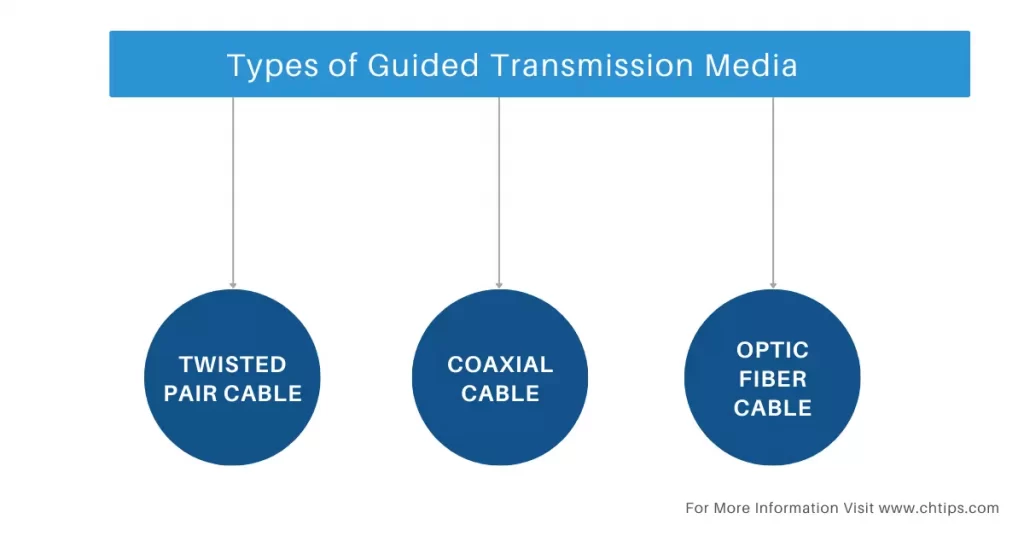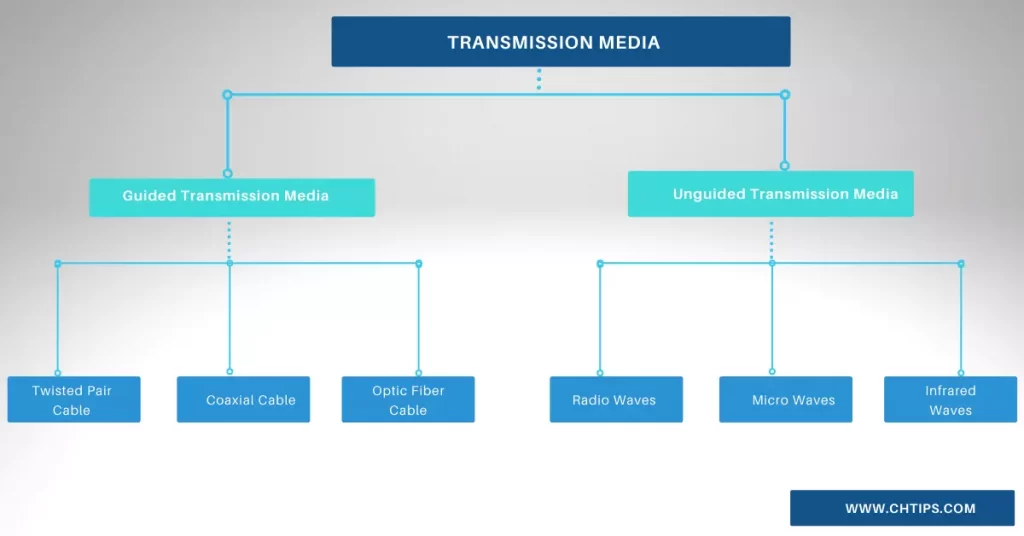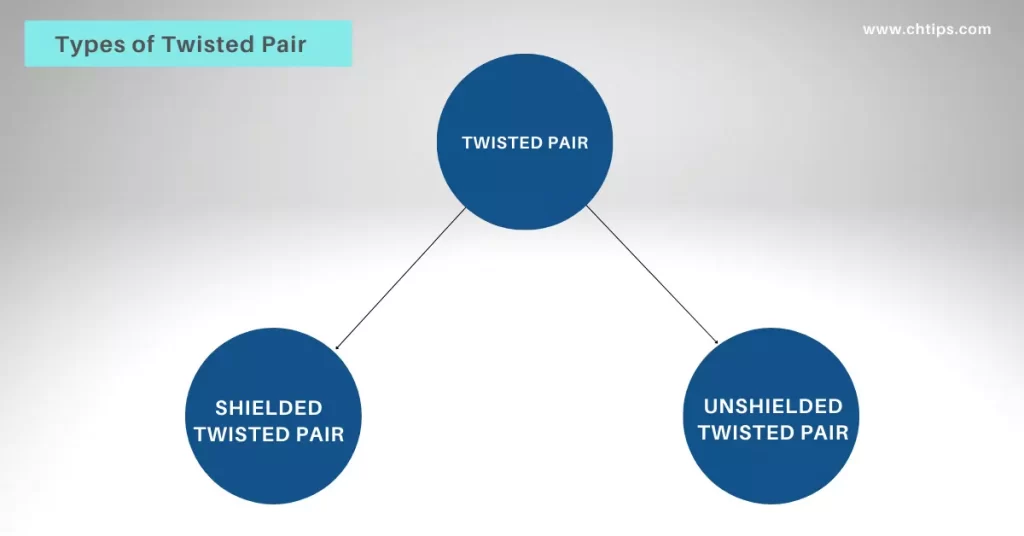In this article, we will learn about what is guided transmission media in computer networks with its advantages, disadvantages, types, and examples with pictures.
What is Guided Transmission Media in Computer Networks Explain with an Example?
The transmission media is nothing but a path where data and information are transferred from one computer (sender) to another computer (receiver).
In simple words, guided media is used and utilized in a computer network where data and information are transferred from one location to another,
For the transmission of data, we need a path or medium that must be capable to transmit or share data and information from one end to another.
This medium is called “Transmission Media”.
There are 2 types of transmission media
- Guided Transmission Media
- Unguided Transmission Media
This transmission media make data sharing and transferring more affordable and simple in computer networks, guided media transmission incorporated physical methods for data transmission.
The computer and devices transfer data and information from one place to another in the form of signals with the help and assistance of magnetic signals.
The guided transmission media are physical entities also they use cables and wires whereas unguided transmission is wireless.
3 Different Types of Guided Transmission Media
The three different types of guided transmission media are
- Twisted Pair Cable
- Coaxial Cable.
- Optic fiber Cable

Twisted Pair Cables
The twisted-pair cables consist of 2 or 4 pairs of conductor wires where 2 wires are in twisted form and are connected with each other.
This is done to avoid electromagnetic interference between the wires.
The twisted-pair cables are of different colors and hence they are easily identified and recognized.
The twisted pair is quite flexible and easy to install. They consist of low bandwidth and the chance of interference is quite high. They are extensively used in local area networks {LAN}.
The twisted pair cables are of two types
- Shielded Twisted Pair Cables.
- Unshielded Twisted Pair Cables.
This method is popular and is extensively used, the twisted pair cable consists of 2 conductors wires which are interconnected with each other and surrounded by insulating material.
These cables are inexpensive and readily available in the market, they are connected to computers and laptops through telephone lines with the help of a modem or hub.
These wires are also used in telephone communications, internal communication systems, local area networks, etc.
Coaxial Cable
The coaxial cables core conductor is made up of a copper cable that is covered with an insulator and the upper surface is covered with copper mesh, inner side of the cable is coated with a non-conductive layer that separates the inner conductor from the outer conductor.
The coaxial cables are used in data transmission also the copper mesh avoids electromagnetic interference.
The bandwidth which coaxial cable produces is relatively higher than twisted-pair cables.
They are capable of producing high-speed data transfer. The coaxial cable shielding is far better than twisted-pair cables.
Analog television and TC networks use these cables extensively. They are so soft and can be easily broken which interrupts data flow.
Optic Fiber Cable
The optic fiber cables are developed with the help of plastic and glass, which uses light reflection to transfer signals from one end to another.
An optic fibre cable uses electrical signals for communication.
The core of the cable is coated with thin glass and plastic material which is called “Cladding”.
The protective coating known as the jacket protects the cable from internal damage.
They produce high bandwidth compared to twisted pair cables and coaxial cables. They are extensively used in huge data transmission with enormous speed.
The optic fiber cables are lightly weighted that generate more bandwidth compared to coaxial cables and twisted pair cables.
The data transmitted by optic fiber cables are in the form of light.
The ranges of optic fibre cables are considerably huge.
Benefits and Advantages of Guided Transmission Media
- The guided transmission media is a physical method used for data transmission.
- They are fast in data transmission from one end to another.
- They are reliable and easy to install.
- They produce a considerable amount of bandwidth.
- The guided transmission media uses cables that are thin and lighter in weight.
- The protective jackets are used to prevent cables from heat and dust and also provide an extra layer of protection and security.
- The guided transmission media uses physical network devices like cables, hubs, switches, switches, and network devices for installing networks for better communications.
- They are inexpensive compared to their counterparts.
Drawbacks and Disadvantages of Guided Transmission Media
- It has a higher attenuation rate.
- The installation cost depends upon the location and sometimes can be expensive.
- For error troubleshooting, professional guidance is required.
- If the cable is damaged the entire networks fall down.
- The risk of cable damage is on the cards.
- Unable to handle huge networks.
- The speed decreases considerably when extra or additional nodes or computers or devices are connected to the network.
- They require huge maintenance.
- Their range of connectivity is compromised, and cannot cover the entire area under networks.
What is Guided Transmission Media in Computer Network With Pictures

Guided and Unguided Transmission Media
| # | Guided Transmission Media | Unguided Transmission Media |
| 1 | Twisted Pair Cable | Radio Waves |
| 2 | Coaxial Cable. | Micro Waves |
| 3 | Optic fiber Cable | Infrared Waves |
Examples of Guided Transmission Media
The examples of guided transmission media’s are
- Phones lines
- Twisted Pair Cables.
- Coaxial Cables.
- Optical Fibre Cables.
Unguided Media in Computer Network
The unguided transmission media in computer networks are also called “Wireless Communications”.
They are considered as the media which does not require physical methods of communication that use cables and wires for better communications.
The guided transmission media uses three-way for communication which are
- Twisted Pair Cable
- Coaxial Cable.
- Optic fiber Cable
On the other hand, unguided transmission media uses
- Radio Waves
- Micro Waves
- Infrared Waves
They are also known as unbounded media; they do not have connectivity limitations like guided media.
They are wireless connections therefore users or new devices can be easily connected to the network without any network device interventions.
Related Articles
- Applications of Star Topology
- Top 11+ Advantages and Disadvantages of MPLS
- Advantages and Disadvantages of Star Topology
- Characteristics of Star Topology Networking in Computer
- Applications of Ring Topology in Computer Network
- Functions of Bridge in Networking
- Features of Star Topology in Computer Networks
- 10 Applications of Star Topology in Real Life
- Characteristics of MAN in Computer Network
- Advantages and Disadvantages of LAN {Local Area Network}
- Advantages and Disadvantages of WAN
- 14+ Difference Between MPLS and VPLS [MPLS Vs VPLS]
- 6+ Advantages and Disadvantages of Application Server
- Characteristics of WAN in Computer Network
- Advantages and Disadvantages of MAN
- Advantages and Disadvantages of DNS
- Different Types of Switching in Computer Network
- Block Diagram of Optical Communication System
- 15+ Advantages and Disadvantages of Mesh Topology
- 10 Features of Ring Topology with Examples
- What is MPLS in Networking
- Active Directory Users and Computers
- Computer Networking Tutorials
- Computer Basic Tutorials
Which is the Example of Economical Guided Media?

The twisted pair is the type of guide transmission media that is a physical media or method which is used to transmit data and information.
This media is economical and inexpensive guided media compared to other transmission media. The cables are light weighted and easy to install and use.
Their maintenance is not huge compared to their counterparts.
Their range is considerably accepted overall and hence popular among the users.
Two types of twisted pair
- Shielded Twisted Pair
- Unshielded Twisted Pair
Frequently Asked Questions [FAQs]
What are the Three Types of Wired Media?
The three types of wired media are twisted pair cables, optic fiber cables, and coaxial cables.
Which Guided Media is Faster in Data Transmission?
The optic fiber cable is considered to be the fastest guided media in data transmission. It transmits data faster than light.
Is Satellite Communication a Type of Guided Media?
No, the statement is false. Satellite communication does not need any physical method to transfer data and information from one location to another; in fact, communication is established through electromagnetic radiation which travels in the air.
Is Bluetooth a Guided Media?
No, Bluetooth is considered to be an unguided transmission media as it does not require any physical methods to transfer or share data and information like twisted pair cables, optic fiber cables, and coaxial cable.
Get in Touch
I have also written and compiled some articles on computers and telecommunications, and please go through them.
I hope you will like reading it.
I hope that all the questions and queries related to what is guided transmission media in computer network with its advantages, disadvantages, types, and examples with pictures have been answered here in easy language.
If you have any questions related to guided media and unguided media.
Don’t hesitate to get in touch with me, and if you need to add, remove or update anything from the article, please let me know in the comment section or via email.
I will be more than happy to update the article. I am always ready to correct myself.
Please share this article with your friends and colleagues; this motivates me to write more related topics.
!!! Thank You !!!
Comments are closed.